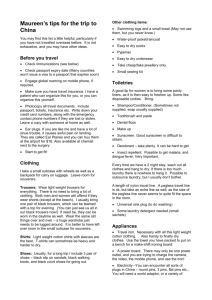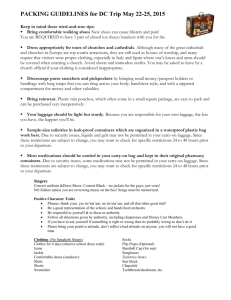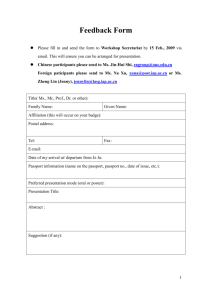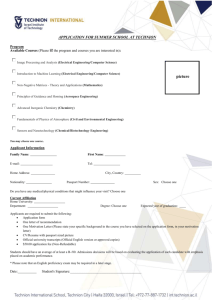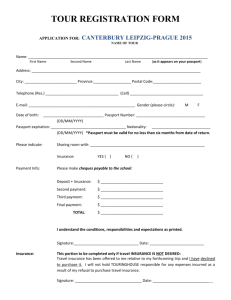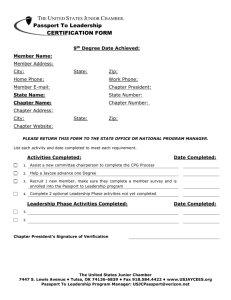KASTEEL Well Suggested Packing List
advertisement
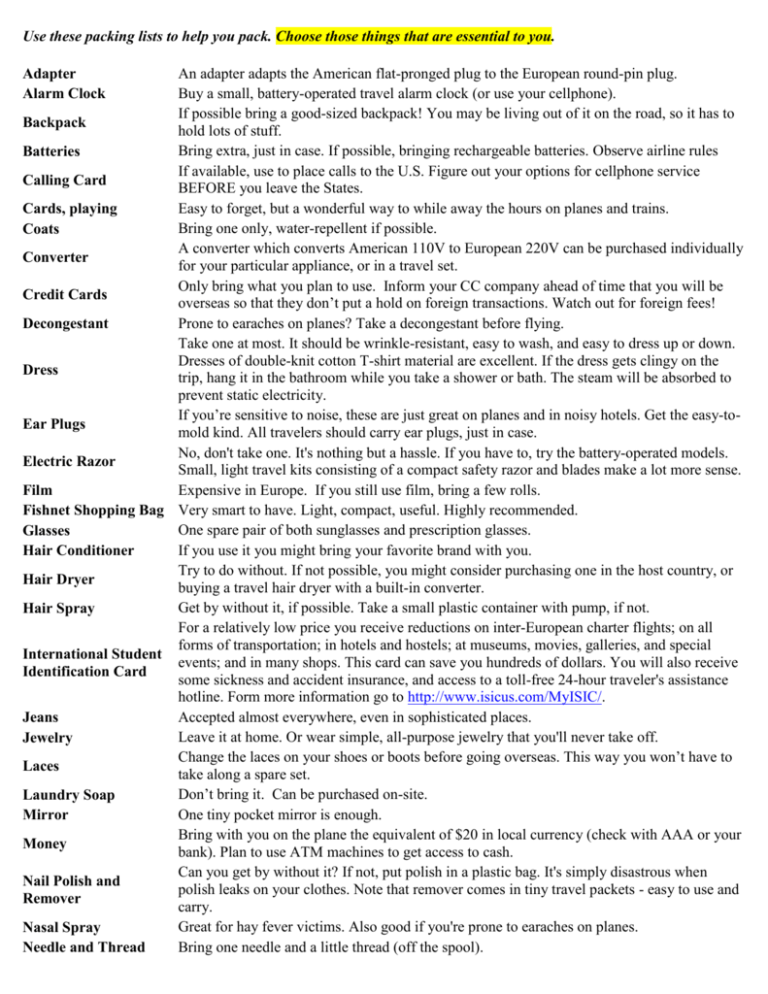
Use these packing lists to help you pack. Choose those things that are essential to you. An adapter adapts the American flat-pronged plug to the European round-pin plug. Buy a small, battery-operated travel alarm clock (or use your cellphone). If possible bring a good-sized backpack! You may be living out of it on the road, so it has to Backpack hold lots of stuff. Bring extra, just in case. If possible, bringing rechargeable batteries. Observe airline rules Batteries If available, use to place calls to the U.S. Figure out your options for cellphone service Calling Card BEFORE you leave the States. Easy to forget, but a wonderful way to while away the hours on planes and trains. Cards, playing Bring one only, water-repellent if possible. Coats A converter which converts American 110V to European 220V can be purchased individually Converter for your particular appliance, or in a travel set. Only bring what you plan to use. Inform your CC company ahead of time that you will be Credit Cards overseas so that they don’t put a hold on foreign transactions. Watch out for foreign fees! Prone to earaches on planes? Take a decongestant before flying. Decongestant Take one at most. It should be wrinkle-resistant, easy to wash, and easy to dress up or down. Dresses of double-knit cotton T-shirt material are excellent. If the dress gets clingy on the Dress trip, hang it in the bathroom while you take a shower or bath. The steam will be absorbed to prevent static electricity. If you’re sensitive to noise, these are just great on planes and in noisy hotels. Get the easy-toEar Plugs mold kind. All travelers should carry ear plugs, just in case. No, don't take one. It's nothing but a hassle. If you have to, try the battery-operated models. Electric Razor Small, light travel kits consisting of a compact safety razor and blades make a lot more sense. Expensive in Europe. If you still use film, bring a few rolls. Film Fishnet Shopping Bag Very smart to have. Light, compact, useful. Highly recommended. One spare pair of both sunglasses and prescription glasses. Glasses If you use it you might bring your favorite brand with you. Hair Conditioner Try to do without. If not possible, you might consider purchasing one in the host country, or Hair Dryer buying a travel hair dryer with a built-in converter. Get by without it, if possible. Take a small plastic container with pump, if not. Hair Spray For a relatively low price you receive reductions on inter-European charter flights; on all forms of transportation; in hotels and hostels; at museums, movies, galleries, and special International Student events; and in many shops. This card can save you hundreds of dollars. You will also receive Identification Card some sickness and accident insurance, and access to a toll-free 24-hour traveler's assistance hotline. Form more information go to http://www.isicus.com/MyISIC/. Accepted almost everywhere, even in sophisticated places. Jeans Leave it at home. Or wear simple, all-purpose jewelry that you'll never take off. Jewelry Change the laces on your shoes or boots before going overseas. This way you won’t have to Laces take along a spare set. Don’t bring it. Can be purchased on-site. Laundry Soap One tiny pocket mirror is enough. Mirror Bring with you on the plane the equivalent of $20 in local currency (check with AAA or your Money bank). Plan to use ATM machines to get access to cash. Can you get by without it? If not, put polish in a plastic bag. It's simply disastrous when Nail Polish and polish leaks on your clothes. Note that remover comes in tiny travel packets - easy to use and Remover carry. Great for hay fever victims. Also good if you're prone to earaches on planes. Nasal Spray Bring one needle and a little thread (off the spool). Needle and Thread Adapter Alarm Clock Nightgown Overcoat Pajamas Pants Passport Passport Photos Passport Wallet / Money Belt Pens Plastic Bags /Ziplocs Plastic Flask Prescription Drugs Rubber or Nylon Braided Clothesline Saline Solution School Supplies Shoes Slippers Sweater Tie Toilet Paper Toothbrush&Paste Towels Umbrella Woolite Almost all experienced women travelers replace a nightgown with a T-shirt. If you take an overcoat, get one made of tightly woven material that doesn't pick up lint, doesn't stain easily, and doesn't wrinkle. Take one coat that best matches your style of travel. Spray the coat with water repellent so that it can double as a raincoat; it can also be used as a bathrobe if you ever have to trip down the hall to take a bath. It makes a good blanket in freezing train compartments: wrap it loosely around yourself like a straitjacket to trap your body heat and keep you warm. Unnecessary? May have to go if you're going to travel light. Don't carry more than two or three pairs, one of which should be jeans. The others should be easy to wash and dark-colored to hide stains. If you forget this, forget the trip. Carry your passport with you at all times and guard it with everything but your life! You'll need it when exchanging currency, picking up mail at poste restante (general delivery) or at American Express, signing in at the hotel, and whenever the police ask to see it. Passport photos can be used in a number of ways - for an international driver's license, for study abroad (identification papers), ski-lift passes, etc. It's a good idea to carry a few extras. A good way to carry a passport, currency, credit cards, papers, etc. Bring a couple with you. Bring along the size and number appropriate to your style of travel. Possible uses: to hold bottles containing liquids, to carry soiled or damp clothes (such as a swimsuit), to protect clothes from the rain (as in backpacking), to sit on at picnics or spectator sports, to hold food A gem, to be filled with water, fruit juice, or whatever. Great for long plane rides when you don't want to rely on the whim of a flight attendant, and especially good for train travel. You may prefer metal to plastic. Metal stands up to abuse and doesn't absorb odors. Take as many prescription drugs as you'll need for the entire length of your stay, plus enough for a week or two to spare. Carry prescriptions with you if you remove drugs from the original containers. And be sure to learn their generic names, in case you lose them. Inexpensive, light, and useful. Great for hanging up wet clothes in limited spaces. If you wear contact lenses, bring enough saline solution to last for the duration. It may cost more in the host country. Do not bring paper, notebooks and other school supplies if you can purchase on-site Don’t bring more than two pairs. You can replace shoes with boots, but don’t take both. Make sure they’re comfortable and waterproof. Do not worry about how they look. Good for use in public showers, etc. Bring the fabric kind that fold into a tiny package. Warm sweaters a must! Wear one to save precious packing space. One at most. Spray it with water repellent. This will make it easy to remove any stains! Remove the core and smash to pack. Tuck a small wad into your purse or wallet. Refill as necessary. This may seem comical - it isn't, as you will find out. Bring a small tube and replenish as needed. Bring two or three (thin) towels. Bring one that folds to less than 14 inches long. Put in outside pockets of your carry-on bag. Bring a few travel packets, if you have any woolen items along. Or purchase on-site. Packing for Study Abroad From Texas A&M Study Abroad General Tips Compiled From Past Participants' Evaluations - Remember: Do not take valuable jewelry. If you take jewelry at all, it should be what you wear all the time (rings, etc.) or costume jewelry. Leave extra space in your bags for things you will want to bring home. .If you need an extra piece of clothing, you can buy it there. Pack things in plastic bags for ease in packing and unpacking. Also, plastic bags come in handy (wet bathing suit, dirty laundry, etc.). Label ALL luggage INSIDE and OUT with your destination. Pack a change of clothes in your carry-on bag in case your luggage is lost. Two Important Rules: I. Take less luggage, clothing, etc., than you think you will need. II. Take more money than you think you will need What To Pack List On the Plane: You will be on the plane for a long time, and you will find that you will get hot and cold as the atmosphere in the plane changes. Some suggestions: Dress in layers to accommodate changes in the temperature as you travel. Wear comfortable, non-binding clothes (i. e. sweats, jeans ). You will want to freshen up periodically, so pack a toothbrush and paste, lip balm, lotion, and contact lens equipment (and extra clothes, in case your luggage is lost) in your carry-on bag. Bring something to read that is not demanding: a mystery novel, light fiction, science fiction, etc. You may want to bring some Dramamine. Tips & Suggestions for Securing Valuables During Travel First Rule: Don't carry everything in one place! Second Rule: Never pack essential documents, medicine, or anything you could not do without in your checked luggage. Put them in your carry-on bag. Never carry large amounts of cash. Try using a necklace pouch or a money belt to carry your cash. Credit Cards: Take only the cards you will use on the trip. Keep a separate list of cards, numbers, and emergency replacement procedures. When making purchases with a credit card, be sure the merchant fills in the correct amount of your purchase. If it ends in zeros, make sure it is the proper amount of zeros with no room to add any more. Insurance: Keep your insurance information in a safe place. Luggage: Mark all luggage-inside and out- with your name and address. If you have an itinerary, put a copy inside each bag. Keep a list of what is in each bag and carry the list with your other documents. Mark your bags in some distinctive way, so they are easily found. Purchase small locks for luggage and backpack and a bicycle chain lock to secure luggage while traveling on the trains. COUNT YOUR LUGGAGE PIECES AT ALL POINTS OF EMBARKING AND DISEMBARKING DURING THE TRIP! Try to travel light. Please note that all carry-on luggage must not be larger that 22 x 14 x 10 inches or weigh more than 22 pounds. Carry-on baggage is expected to fit under the seat in the cabin! Medicines: Take all you need for the entire trip. Take a copy of prescriptions, with generic names of drug. Keep medicines in original containers. Take extra glasses and prescription for lenses. Passport: Carry with you - separate from passport - two extra passport pictures, passport number, date and place of issue, and a certified - NOT photocopied - copy of your birth certificate or an expired passport. If your passport is lost, report it to the local police. Get a written confirmation of the report, and take the above documents to the nearest United State Consulate and apply for a new passport. Make a xerox copy of the front two I.D. pages of your passport and keep it in a safe place. Summer or Short Semester Luggage: Two bags max! You will usually be living in a dorm and space will be limited. Money: Cash - A very small amount (not more than $50) in small bills ($10's or less) Traveler's checks - Should be in $20 or $50. ATM Card and Visa Debit Card will usually work. Credit Cards is optional but convenient. REMEMBER WHEN PACKING: Pack only what you can carry comfortably. You will always be carrying your own luggage. TOILETRIES: Soap two towels one washcloth Toothbrush & toothpaste Shampoo & conditioner (small amounts; you can always buy more there if you run out) Deodorant Shaving cream, disposable razor Brush, combs (and pins, rubber bands, and clips if you wear your hair up) Tampons/pads (for women) Contact lens solutions, an extra pair of lenses, and your prescription Special medications (any prescriptions you may need, in pharmacy-labeled bottles) Insect repellent lotion THE BASICS: Plan for comfort, not fashion. Cotton clothing is preferable; you can wash it in the sink or shower and let drip dry. Plan your wardrobe to be interchangeable e.g., colors and pieces that you can wear in a variety of combinations. Underwear (one week's supply) Socks (several pair) 1 pair of jeans Skirt/nice pants (for women) or dressier slacks (for men) Short-sleeve tops/shirts Two pairs shoes (both comfortable to walk in - suggested: 1 nice pair and 1 pair tennis shoes) Work shoes/heavy shoes Four-five pairs shorts/walking shorts Pajamas and robe or other night-time cover-up Hat (functional, not fashionable - due to the intensity of the sun) Rain poncho, Canteen or beverage container for water OPTIONAL GEAR (Remember you have to carry all of this) Extra socks/stockings Rubber thongs/flip-flops (good idea for showering) Purse, or around the neck pouch Make-up Camera, film Watch, travel alarm clock Sunglasses Address book Recreational materials cards, books, frisbee, dominoes, etc. COURSE MATERIALS: TRANSPORTATION: Wear comfortable, non-binding clothes. Music (CD's, for either group or your own portable electronic music device) You may want to bring some Dramamine Packing List What you bring to your program depends largely upon where you study and who you are. In general, past participants recommend the following: General Packing Tips Clearly identify your luggage inside and out with your name and US & overseas address Place a strap or piece of rope around your suitcase to secure it in case the lock breaks Check airline regulations for weight, size and number of bags In your carry-on, keep a change of clothes, toiletries, valuables, important documents (passports, visas, arrival instructions) and medication Miscellaneous $100 in local currency for when you first arrive Map of your host city Guidebook of your region and of the places where you will travel Photocopy of your passport information pages. Also leave a copy at home. International calling card and access numbers for the countries where you will travel. Phone numbers to cancel credit cards in case of theft (800 numbers don't work outside US) Board games or cards, as you may not have a TV iPod or shock absorbent CD player, portable speakers, power supply Digital camera Journal Addresses and photos of family and friends Favorite recipes (note metric & Celsius conversions) Small items to use as gifts (e.g., school decals, magnets) Travel alarm clock Umbrella Sunglasses Small sewing kit Money belt Day pack (for short trips; this could double as your carry-on) If you plan to travel, Swiss army knife with bottle opener, corkscrew, & can opener, absorbent fast-drying and small-to-pack towel (available at outdoors stores like Erehwon, Fontana and REI) If you bring a laptop, inquire about international voltage converters at an electronics store Power strip so you only have to purchase one converter (if you plan to bring several items that require plug-in to an electrical outlet) Purchase bedding, linens and kitchenware abroad, if your finances permit. They take up a lot of space and are easy to find overseas. Your advisor’s email address Clothing Consider both the physical & social climate; dress accordingly. Persons in other countries tend to dress a bit more formally than we do in the US. Observe host country’s rules of modesty. Dark colors do not show dirt as readily Take durable, drip-dry, no-iron clothes Take items that have multiple uses and (for colder climates) can be layered. Comfort and practicality are the keys for both clothing and shoes Bring one professional outfit in case of a site visit to a company or job/internship interview Bring comfortable walking shoes. Toiletries Don't overstock on toiletries; most things are available in major cities abroad. Women may want to bring a preferred brand of tampons or pads, as they may not be as readily available abroad. Transfer liquids from breakable containers into plastic containers; use tape to seal the lids when traveling or pack them in ziploc bags to separate them from clothing Prescription drugs for the duration of your time abroad Extra eyeglasses Pocket pack of Kleenex Voltage Most appliances you have purchased in the U.S. are designed to work on 110 voltage, while most of the world outside the U.S. and Canada operates on 220 voltage. To convert the 220 voltage energy to 110 voltage (for your appliance to function), you will need to purchase a travel voltage converter (or, if the appliance is relatively inexpensive, purchase a new one in the host country). Countries that operate on 220 voltage include Austria, Chile, China, Denmark, Hong Kong, Norway and the United Kingdom. Countries that use both 110 and 220 voltage within their borders include France, Germany, Italy, Mexico, Singapore, Spain and Sweden. Voltage isn’t the only thing that varies from country to country. Electrical wall outlets also differ in shape, assortment and arrangement of holes. To be prepared, make sure you get an adapter set to go with the converter.
